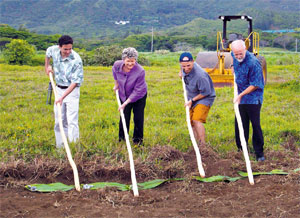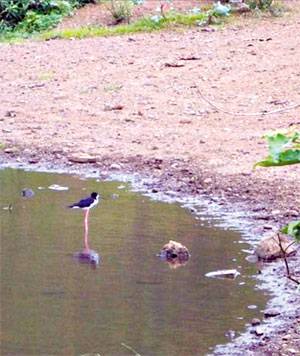Wetland Restorations Under Way At Kawainui

State Reps. Chris Lee and Cynthia Thielen (far left) bring their o‘o sticks to the June 28 groundbreaking for Kawainui Marsh improvements, a joint effort of the U.S. Army Corps of Engineers and the state Department of Land and Natural Resources. With them are retired fish and wildlife administrator Mike Buck (in cap) and DLNR state parks administrator Dan Quinn. Photo from the Office of Cynthia Thielen.
Rep. Cynthia Thielen
The Kawainui Marsh Environmental Restoration Project is now under way, after decades of collaborative efforts between Kailua residents, community groups, and government officials and agencies on the city, state and federal levels.
With the creation of 11 wetland pond cells within 37 acres at the mauka end of the marsh, this project is a significant step in restoring the natural wetland habitat for our native water birds. The U.S. Army Corps of Engineers is conducting the work in partnership with the state Department of Land and Natural Resources’ Division of Fish and Wildlife (DoFaW).
The Kawainui-Hamakua Marsh Complex received international recognition in 2005 when it was designated as a Ramsar Wetland of International Importance (visit ramsar.org). While there are many people and organizations that have helped secure protections for the marsh, there are a couple women in particular who played instrumental roles in raising awareness of Kawainui’s unique, valuable resources and securing its protection and restoration.
Muriel Seto worked to protect the marsh from the 1960s and continued her efforts for decades through her leadership in Hawaii’s Thousand Friends and other groups. Her commitment and dedication to this goal were outstanding, and we owe her our gratitude. Donna Wong has carried on this tradition at HTF, for which we are equally fortunate.

An ae‘o (Hawaiian stilt) visits the Kawainui Marsh project site. Photo from the Office of Cynthia Thielen.
Facts about Kawainui Marsh
• It encompasses approximately 830 acres and is Hawaii’s largest remaining wetland habitat. • It is located in what was once the center of a caldera of the Ko‘olau shield volcano and is considered sacred by the Native Hawaiian people. • It provides an important habitat for four endangered species of native Hawaiian water birds: ae‘o kukuluao (stilt), ‘alae ke‘oke‘o (coot), koloa maoli (duck) and ‘alae ‘ula (gallinule). • There are many important cultural sites in and around the marsh, including three heiau, the largest fish pond (450 acres), numerous ancient lo‘i and 1,500-year-old settlement sites.
• It provides critical flood control and sediment filtration that protects and benefits thousands of residents and the entire Kailua Bay ecosystem. • It is one of only 34 United States wetlands on the Ramsar list. It was added to the list Feb. 2, 2005 and was the second Pacific Islands wetland to receive the Wetland of International Importance designation (after the Marshall Islands’ Jaluit Atoll in 2004). • The Ramsar Convention initially convened Feb. 2, 1971 in Ramsar, Iran and is an international treaty for the conservation and sustainable utilization of wetlands. It has designated 2,040 sites worldwide.





